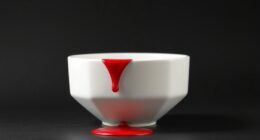In East Asia, giving jade as a gift symbolizes good fortune, protection, and spiritual harmony. It’s often exchanged during festivals and special occasions to bring success, health, and prosperity. Jade’s colors and carvings add meaning—green for luck, white for purity, and intricate designs for protection. Such gifts strengthen bonds, honor tradition, and serve as lasting tokens of respect and love. If you want to explore more about these meaningful customs, keep exploring further.
Key Takeaways
- Jade gifts symbolize good fortune, prosperity, and spiritual protection in East Asian cultures.
- They are often given during special occasions to convey wishes for success and longevity.
- Jade carvings and jewelry represent cultural values, emotional bonds, and social status.
- The color and type of jade carry specific meanings, such as health, purity, or luck.
- Gifting jade connects physical and spiritual worlds, reinforcing traditions of respect, family bonds, and harmony.
The Symbolism of Jade in East Asian Cultures

Jade holds a profound symbolic significance in East Asian cultures, representing more than just beauty or wealth. You’ll find intricate jade carvings depicting mythical creatures like dragons and phoenixes, which symbolize power, protection, and good fortune. These carvings aren’t just decorative; they convey deep cultural meanings and spiritual beliefs. Mythical creatures carved from jade are believed to ward off evil spirits and bring harmony. The stone’s durability and luminous quality reinforce its association with strength and purity. When gifted or displayed, jade objects and carvings serve as talismans that embody cultural values and hopes for well-being. Additionally, cultural significance of jade is often reflected in traditional ceremonies and personal adornments, emphasizing its enduring importance across generations. Recognizing the spiritual symbolism of jade helps deepen appreciation for its role in East Asian traditions and customs. Moreover, the resilience of jade enhances its status as a treasured material that endures through time and changing fashions, further cementing its cultural importance.
Jade as a Gift of Good Fortune and Prosperity
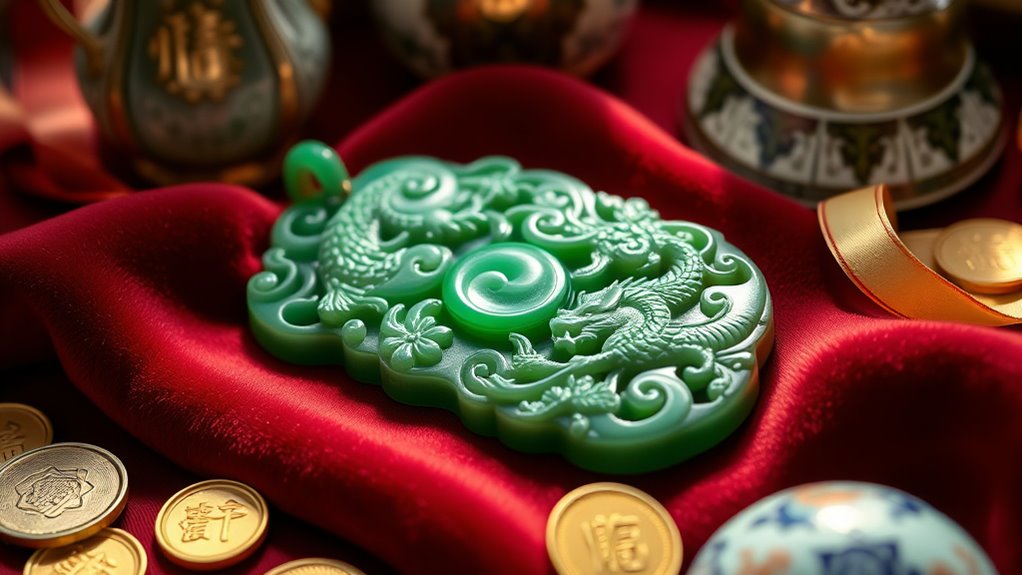
You’ll see that giving jade as a gift is deeply tied to wishes for wealth and success. Its cultural significance makes it a meaningful gesture, especially during special occasions. By understanding these traditions, you can appreciate why jade remains a popular symbol of good fortune across East Asia. Additionally, the aesthetic appeal of jade enhances its value as a gift, making it both beautiful and meaningful. The cultural significance of jade also encompasses its association with spiritual protection and harmony, further elevating its importance as a gift. Furthermore, the influence of WWE Raw’s Financial Impact demonstrates how cultural symbols can hold significant monetary and social value, highlighting the importance of meaningful gestures like giving jade.
Symbols of Wealth
In East Asian cultures, giving jade as a gift is more than a gesture of appreciation; it’s a powerful symbol of wealth, good fortune, and prosperity. Jade’s association with material authenticity elevates its status, making it a prized luxury item that signifies financial success. When you present jade, you’re not just offering a beautiful object but also conveying your hopes for ongoing prosperity. Its reputation as a luxury branding piece ensures that recipients see it as a sign of prestige and affluence. The quality and authenticity of the material matter greatly—genuine jade reflects sincerity and respect. By choosing authentic jade, you align your gift with cultural values tied to wealth and success, reinforcing your generous intent and social standing.
Cultural Significance
Given its strong association with wealth and status, jade is often regarded as more than just a luxurious material—it embodies hopes for good fortune and ongoing prosperity. In East Asian cultures, jade symbolizes spiritual harmony and protection, making it a meaningful gift for those seeking luck. Many believe that jade’s qualities extend beyond beauty, as it’s also linked to jade and spirituality, fostering inner peace and spiritual growth. Additionally, jade’s role in traditional medicine highlights its healing properties, believed to promote health and balance. When given as a gift, jade conveys blessings of prosperity, wellness, and spiritual well-being. Its cultural significance makes it a cherished token that embodies wishes for a prosperous and harmonious life. Furthermore, the cultural adaptations surrounding jade gifts emphasize personal and familial well-being, reinforcing their importance across generations.
Gift-Giving Traditions
Why is jade such a popular gift choice during special occasions in East Asia? Because it symbolizes good fortune and prosperity, making it a meaningful gesture. When giving jade, you often select pieces crafted with intricate carving techniques that highlight its beauty and spiritual significance. The jade market dynamics influence the availability and value of different types, affecting your choices. Additionally, understanding the traditional symbolism behind jade enhances the thoughtfulness of your gift. Recognizing the cultural significance of jade further enriches the gesture, as it embodies positive energies and auspicious meanings in East Asian traditions. Furthermore, the artistic craftsmanship involved in creating jade pieces reflects the cultural heritage and skilled artisanship valued in these societies.
The Role of Jade in Celebrations and Rituals
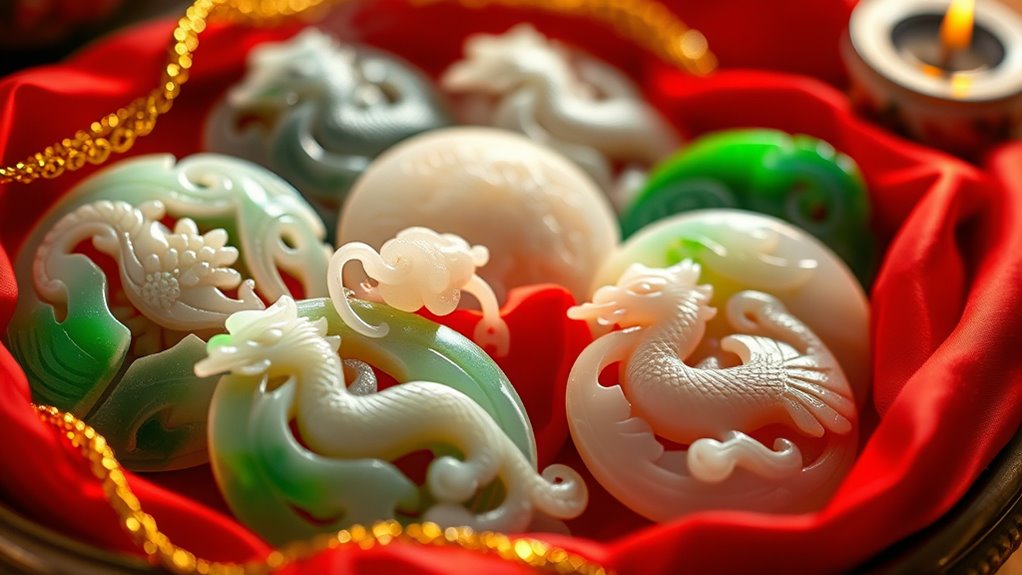
Jade plays an essential role in celebrations and rituals across East Asia, symbolizing purity, protection, and spiritual harmony. During important events, you might witness intricate jade carving techniques used to create amulets or ornaments that carry deep meaning. Jade purification rituals are common before ceremonies, where you cleanse the jade to remove negative energy and prepare it for spiritual use. In festivals, jade pieces are often gifted to bring good luck or ward off evil spirits. These traditions reinforce the belief that jade connects the physical and spiritual worlds. The ongoing development of AI safety measures is also crucial to maintaining the integrity of cultural practices involving jade. Additionally, understanding the cultural significance of jade enhances appreciation for its enduring role in East Asian societies. Whether in ancestral rites or joyous celebrations, jade’s presence highlights its significance in honoring traditions and fostering harmony within communities. The cultural symbolism of jade often includes its association with longevity and wisdom, further enriching its importance in rituals and festivities.
Variations in Jade Significance Across Countries
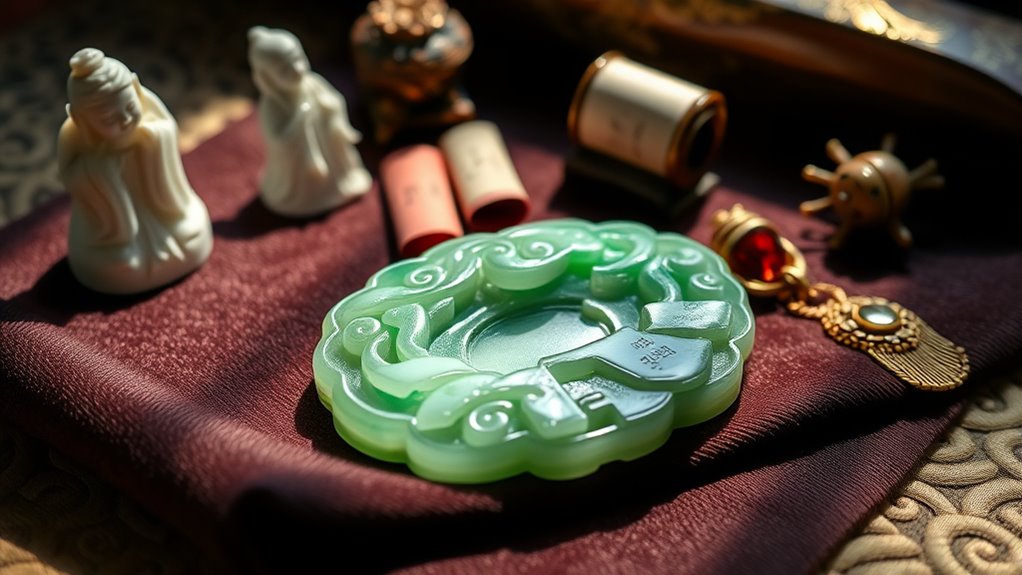
Across East Asia, the significance of jade varies from country to country, reflecting diverse cultural beliefs and historical traditions. Historical trade routes facilitated the exchange of jade, influencing local perceptions and customs. In China, jade symbolizes purity and immortality, rooted in ancient rituals and imperial use. Japan views jade as a protective talisman, connected to spiritual harmony, while Korea considers it a symbol of status and longevity. Regional variations develop from differing historical trade interactions, cultural values, and local legends. For example, Chinese jade’s importance is heightened by its association with imperial authority, whereas in Japan, subtle aesthetic qualities drive its significance. These differences highlight how regional variations shape the unique cultural meanings attributed to jade across East Asian countries. Additionally, the color and craftsmanship of jade pieces often reflect regional artistic styles and cultural priorities, further emphasizing local interpretations.
Types and Colors of Jade and Their Cultural Meanings

Different types and colors of jade carry distinct cultural meanings that influence their value and symbolism in East Asia. For example, jadeite and nephrite are popular, each with unique qualities shaped by jade carving techniques. Green jade symbolizes health and prosperity, while white jade represents purity and peace. Red and lavender jade are associated with good luck and spiritual insight. The jade market trends show a growing demand for high-quality, vividly colored stones, impacting their worth. When choosing jade gifts, consider these cultural associations to convey specific messages. The variety of jade types and colors enhances their significance, making them powerful symbols in East Asian traditions. Additionally, the cultural symbolism of jade can vary across regions and periods, adding further depth to its meaning. Recognizing the regional variations in jade symbolism can help you select more meaningful and culturally appropriate gifts. Your understanding of these differences allows you to select meaningful and culturally appropriate jade gifts. Exploring historical uses of jade can deepen your appreciation for its significance in East Asian culture.
Jade Jewelry and Its Reflection of Social Bonds
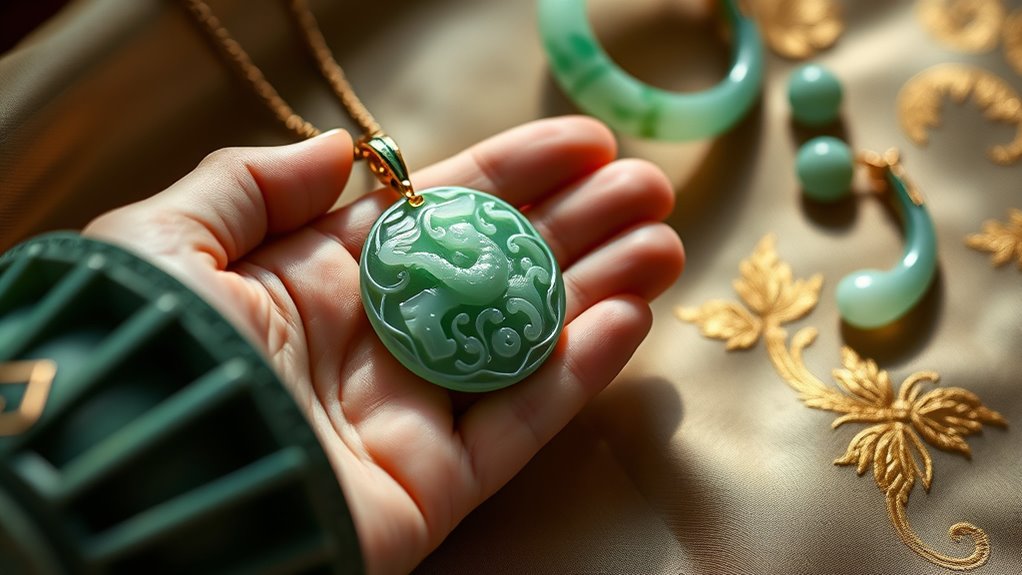
Jade jewelry often symbolizes deep affection and strengthens social bonds in East Asian cultures. It also carries significant cultural heritage, reflecting shared traditions and values. By wearing or exchanging jade pieces, you emphasize family connections and uphold important social customs. Additionally, the act of gifting jade can serve as a form of cultural expression, embodying respect and good wishes across generations. The enduring value of jade is also linked to its sound design qualities, which have historically inspired artisans and craftsmen to create intricate and meaningful jewelry pieces.
Symbols of Affection
Because jade has long symbolized purity and harmony, wearing jade jewelry often signifies more than personal taste—it reflects deep social bonds and shared values. When you give or wear jade, you’re expressing affection and commitment, often rooted in tradition. The intricate jade art and craftsmanship techniques used in creating jewelry highlight the effort and care behind each piece, making it a meaningful gift. Jade jewelry can symbolize lifelong connections, like between family members or lovers. It’s common to see jade carved into symbols of protection, love, or unity, emphasizing emotional bonds. Additionally, cultural significance associated with jade enhances its value as a treasured token of affection. Understanding cultural symbolism can deepen appreciation for jade’s role in social relationships. Recognizing the craftsmanship techniques involved in jade jewelry further emphasizes its importance as a cultural artifact. By choosing jade as a gift, you’re not only sharing beauty but also reinforcing your social bonds, making it a treasured token of affection.
Cultural Heritage Significance
Cultural heritage deeply influences the significance of jade jewelry, serving as a tangible link to traditions that have endured for centuries. You can see this in its historical context, where jade symbolized power, purity, and protection. The artistic craftsmanship behind each piece reflects centuries of skill passed down through generations, making the jewelry more than adornment—it’s a cultural artifact. Jade’s role in social bonds is evident in ceremonies and rites, reinforcing community ties. The table below highlights key aspects:
| Aspect | Description | Significance |
|---|---|---|
| Historical context | Jade’s symbolism throughout history | Power, purity, protection |
| Artistic craftsmanship | Handcrafted techniques across eras | Cultural mastery |
| Cultural preservation | Maintaining traditional methods | Continuity of heritage |
| Cultural significance | The enduring importance of jade in social rituals | Deep cultural meaning |
Through these elements, jade jewelry embodies a deep cultural heritage that connects you to East Asia’s social and artistic history.
Family Connection Emphasis
Have you ever noticed how jade jewelry often serves as a symbol of family bonds in East Asia? It’s more than just adornment; it reflects deep connections and shared history. Jade pieces are often family heirlooms passed down through generations, strengthening generational bonds. Wearing or gifting jade signifies respect and love within families. It’s common to see jade jewelry given during important milestones, like weddings or birthdays, symbolizing unity. These pieces serve as tangible links to ancestors, reminding you of your roots. Jade’s enduring quality makes it ideal for representing lasting family ties. Whether as a pendant, bracelet, or ring, jade embodies the continuity and strength of family relationships that stand the test of time. Additionally, the benefits of curiosity highlight how engaging with cultural symbols like jade can deepen personal understanding and emotional connection. Exploring the symbolic significance of jade can also enhance appreciation for its role in fostering cultural identity and social cohesion.
Modern Interpretations and Continuing Traditions

Modern interpretations of jade gifts blend age-old symbolism with contemporary aesthetics, allowing you to appreciate traditional values while embracing new styles. In contemporary fashion, jade jewelry now features sleek designs and minimalistic forms that appeal to modern tastes. You might see jade incorporated into everyday accessories like rings, pendants, or even smartphone charms, reflecting ongoing cultural significance. Digital symbolism also plays a role, with jade often used in virtual gifts or digital art, symbolizing luck and protection in digital spaces. These evolving trends maintain the essence of jade’s cultural meaning while making it relevant today. By blending tradition with innovation, jade remains a meaningful gift, connecting past and present in meaningful ways.
Frequently Asked Questions
How Has the Perception of Jade Evolved in Contemporary East Asian Societies?
You might notice that jade’s perception has shifted with modern consumerism, making it more about fashion and status than traditional symbolism. Celebrities often endorse jade jewelry, increasing its appeal among younger generations. While it still holds cultural significance, many now see jade as a trendy accessory or an investment. This evolution reflects how contemporary society balances respect for tradition with the influence of global trends and celebrity culture.
Are There Specific Etiquette Rules for Gifting Jade in Different East Asian Cultures?
When you give jade as a gift in East Asia, you should follow specific gift giving etiquette to show respect and avoid cultural taboos. For example, in China, present jade with both hands, and avoid giving it during funerals or in sets of four, which is considered unlucky. In Japan, choose simple, elegant pieces, and avoid overly expensive gifts. Respecting these customs guarantees your gift is well-received and appreciated.
What Are the Spiritual or Mystical Beliefs Associated With Jade in East Asia?
Did you know that over 60% of East Asians believe jade holds spiritual symbolism? You might be surprised to learn that jade is thought to possess mystical properties, like protecting against evil spirits and attracting good fortune. In East Asia, people see jade as more than just a beautiful stone; it’s believed to carry deep spiritual significance, offering blessings, health, and harmony through its mystical properties and spiritual symbolism.
How Do Economic Factors Influence Jade’s Cultural Significance Today?
You’ll notice that economic factors, like market valuation and trade dynamics, shape jade’s cultural significance today. When demand rises, the value of jade increases, making it a symbol of wealth and status. Trade routes and market fluctuations also impact how accessible jade is, influencing its cultural importance. As a result, jade remains a cherished symbol, but its significance can fluctuate based on economic trends and market conditions.
Are There Regional Myths or Legends Linked to Particular Jade Artifacts?
Did you know that many regions have myths tied to jade artifacts? For example, in China, legendary artifacts are believed to possess mythical origins that grant protection or wisdom. One famous artifact, the Hetian jade pendant, is linked to legends of divine power. Regional myths often elevate these objects beyond mere beauty, making them symbols of spiritual strength and cultural heritage, deeply embedded in local legends and stories.
Conclusion
As you hold a jade gift, imagine its smooth surface warm beneath your fingertips, symbolizing wishes for luck and harmony. Its vibrant hues shimmer like the dawn’s first light, carrying centuries of meaning across East Asia. Whether worn as jewelry or given as a token, jade connects you to traditions that celebrate prosperity and unity. In its timeless glow, you find a bridge between past and present, a sacred gift that endures through generations.








